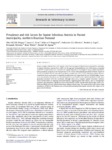Por favor, use este identificador para citar o enlazar este ítem:
http://www.alice.cnptia.embrapa.br/alice/handle/doc/973032Registro completo de metadatos
| Campo DC | Valor | Lengua/Idioma |
|---|---|---|
| dc.contributor.author | BORGES, A. M. C. M. | pt_BR |
| dc.contributor.author | SILVA, L. G. | pt_BR |
| dc.contributor.author | NOGUEIRA, M. F. | pt_BR |
| dc.contributor.author | OLIVEIRA, A. C. S. | pt_BR |
| dc.contributor.author | SEGRI, N. J. | pt_BR |
| dc.contributor.author | FERREIRA, F. | pt_BR |
| dc.contributor.author | WITTER, R. | pt_BR |
| dc.contributor.author | AGUIAR, D. M. | pt_BR |
| dc.date.accessioned | 2013-12-06T11:11:11Z | pt_BR |
| dc.date.available | 2013-12-06T11:11:11Z | pt_BR |
| dc.date.created | 2013-12-06 | pt_BR |
| dc.date.issued | 2013 | pt_BR |
| dc.identifier.citation | Research in Veterinary Science, v. 95, n. 1, p. 76-81, 2013. | pt_BR |
| dc.identifier.issn | 0034-5288 | pt_BR |
| dc.identifier.uri | http://www.alice.cnptia.embrapa.br/alice/handle/doc/973032 | pt_BR |
| dc.description | Serum samples collected from 547 equids in the Pantanal region of Brazil were evaluated for antibodies to Equine Infectious Anemia Virus (EIAV) by the agar gel immunodiffusion test. Risk factors associated with EIAV seropositivity were evaluated and spatial dependence investigated using a Spatial Lag Model. EIAV prevalence on farms in the Pantanal was 52.0% (13/25) with adjusted prevalence between equids of 31.5% (17.4?48.8% 95% CI). Intra-herd prevalence ranged from 5.0 to 77.0%. Statistical analysis demonstrated that farms and animals in regularly flooded areas had respectively 60 and 146 fold higher chance to be sero-positive than farms and animals located in non-flooded areas. Spatial Lag Model results were generally consistent with this conclusion although there was a negative spatial correlation between farms located within in regularly inundated regions, suggesting that other factors, such as management practices, probably play a significant role in transmission of EIAV. Equids with clinical signs were 3.74- fold more likely to be sero-positive than those without clinical signs. The results of this work reveal a high prevalence of EIAV in the Pantanal area of Brazil demonstrating that equids reared in this region are at great risk of infection. | pt_BR |
| dc.language.iso | eng | eng |
| dc.rights | openAccess | eng |
| dc.subject | Equid | pt_BR |
| dc.subject | EIAV | pt_BR |
| dc.subject | Risk factor | pt_BR |
| dc.subject | Mato grosso state | pt_BR |
| dc.title | Prevalence and risk factors for Equine Infectious Anemia in Poconé municipality, northern Brazilian Pantanal. | pt_BR |
| dc.type | Artigo de periódico | pt_BR |
| dc.date.updated | 2013-12-06T11:11:11Z | pt_BR |
| dc.subject.nalthesaurus | Brazil | pt_BR |
| dc.subject.nalthesaurus | seroprevalence | pt_BR |
| dc.format.extent2 | 6p. | pt_BR |
| riaa.ainfo.id | 973032 | pt_BR |
| riaa.ainfo.lastupdate | 2013-12-06 | pt_BR |
| dc.contributor.institution | ALICE M. C. M. BORGES, UFMT; LUCAS G. SILVA, UFMT; MARCIA FURLAN NOGUEIRA T DE LIMA, CPAP; ANDERSON C. S. OLIVEIRA, UFMT; NEUBER J. SEGRI, UFMT; FERNANDO FERREIRA, USP; RUTE WITTER, UFMT; DANIEL M. AGUIAR, UFMT. | pt_BR |
| Aparece en las colecciones: | Artigo em periódico indexado (CPAP)  | |
Ficheros en este ítem:
| Fichero | Descripción | Tamaño | Formato | |
|---|---|---|---|---|
| 1s2.0S0034528813000659main.pdf | 547,83 kB | Adobe PDF |  Visualizar/Abrir |









